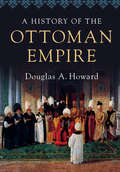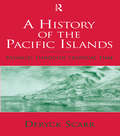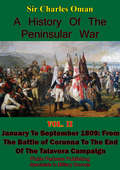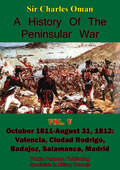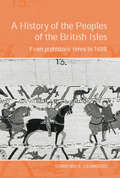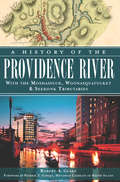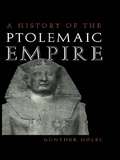- Table View
- List View
A History of the Ottoman Empire
by Howard Douglas A.Covering the full history of the Ottoman Empire, from its genesis in post-Mongol Eurasia to its dissolution after the Great War in Europe, this textbook takes a holistic approach, considering the Ottoman worldview - what it was, how it came together, and how it fell apart. Douglas A. Howard stresses the crucial role of the Ottoman sultans and their extended household, discusses the evolution of the empire's fiscal model, and analyzes favorite works of Ottoman literature, emphasizing spirituality, the awareness of space and time, and emotions, migration, violence, disease, and disaster. Following how people spent their time, their attitudes towards authority, how they made their money, and their sense of humor and sense of beauty, this illustrated textbook is an essential resource for graduate and advanced undergraduate, courses on the history of the Ottoman Empire, the Middle East, Islamic history, and the history of Eastern Europe. The book includes over eighty illustrations, maps and textboxes.
A History of the Ozarks, Volume 1: The Old Ozarks
by Brooks BlevinsGeologic forces raised the Ozarks. Myth enshrouds these hills. Human beings shaped them and were shaped by them. The Ozarks reflect the epic tableau of the American people—the native Osage and would-be colonial conquerors, the determined settlers and on-the-make speculators, the endless labors of hardscrabble farmers and capitalism of visionary entrepreneurs. The Old Ozarks is the first volume of a monumental three-part history of the region and its inhabitants. Brooks Blevins begins in deep prehistory, charting how these highlands of granite, dolomite, and limestone came to exist. From there he turns to the political and economic motivations behind the eagerness of many peoples to possess the Ozarks. Blevins places these early proto-Ozarkers within the context of larger American history and the economic, social, and political forces that drove it forward. But he also tells the varied and colorful human stories that fill the region's storied past—and contribute to the powerful myths and misunderstandings that even today distort our views of the Ozarks' places and people. A sweeping history in the grand tradition, A History of the Ozarks, Volume 1: The Old Ozarks is essential reading for anyone who cares about the highland heart of America.
A History of the Ozarks, Volume 2: The Conflicted Ozarks
by Brooks BlevinsThe Ozarks of the mid-1800s was a land of divisions. The uplands and its people inhabited a geographic and cultural borderland straddling Midwest and west, North and South, frontier and civilization, and secessionist and Unionist. As civil war raged across the region, neighbor turned against neighbor, unleashing a generation of animus and violence that lasted long after 1865.The second volume of Brooks Blevins's history begins with the region's distinctive relationship to slavery. Largely unsuitable for plantation farming, the Ozarks used enslaved persons on a smaller scale or, in some places, not at all. Blevins moves on to the devastating Civil War years where the dehumanizing, personal nature of Ozark conflict was made uglier by the predations of marching armies and criminal gangs. Blending personal stories with a wide narrative scope, he examines how civilians and soldiers alike experienced the war, from brutal partisan warfare to ill-advised refugee policies to women's struggles to safeguard farms and stay alive in an atmosphere of constant danger. The war stunted the region's growth, delaying the development of Ozarks society and the processes of physical, economic, and social reconstruction. More and more, striving uplanders dedicated to modernization fought an image of the Ozarks as a land of mountaineers and hillbillies hostile to the idea of progress. Yet the dawn of the twentieth century saw the uplands emerge as an increasingly uniform culture forged, for better and worse, in the tumult of a conflicted era.
A History of the Ozarks, Volume 3: The Ozarkers
by Brooks BlevinsBetween the world wars, America embraced an image of the Ozarks as a remote land of hills and hollers. The popular imagination stereotyped Ozarkers as ridge runners, hillbillies, and pioneers—a cast of colorful throwbacks hostile to change. But the real Ozarks reflected a more complex reality. Brooks Blevins tells the cultural history of the Ozarks as a regional variation of an American story. As he shows, the experiences of the Ozarkers have not diverged from the currents of mainstream life as sharply or consistently as the mythmakers would have it. If much of the region seemed to trail behind by a generation, the time lag was rooted more in poverty and geographic barriers than a conscious rejection of the modern world and its progressive spirit. In fact, the minority who clung to the old days seemed exotic largely because their anachronistic ways clashed against the backdrop of the evolving region around them. Blevins explores how these people’s disproportionate influence affected the creation of the idea of the Ozarks, and reveals the truer idea that exists at the intersection of myth and reality. The conclusion to the acclaimed trilogy, The History of the Ozarks, Volume 3: The Ozarkers offers an authoritative appraisal of the modern Ozarks and its people.
A History of the Pacific Islands
by Steven Roger FischerFrom the back cover: This wide-ranging study of the Pacific Islands provides a dynamic and provacative account of the peopling of the Pacific, and its broad impact on world history. Spanning nearly 50,000 years of human presence in an area which comprises one-third of our planet - Melanesia, Micronesia and Polynesia - the narrative follows the development of the region, from New Guinea's earliest settlement to the creation of the modern Pacific states.
A History of the Pacific Islands, Second Edition (Macmillan Essential Histories)
by Steven Roger FischerThis wide-ranging study of the Pacific Islands provides a dynamic and provocative account of the peopling of the Pacific, and its broad impact on world history. Spanning nearly 50,000 years of human presence in an area which comprises one-third of our planet - Melanesia, Micronesia and Polynesia - the narrative follows the development of the region, from New Guinea's earliest settlement to the creation of the modern Pacific states. It also examines the fascinating processes which have contributed to the formation of the hybrid Pacific we know today. <P><P>A History of the Pacific Islands <ul> <li>traces the extraordinarily varied genealogy of all Pacific peoples, looking at their descent from Papuan tribesmen, Austronesian mariners and foreign colonists</li> <li>examines the rich inheritance of the Islands as a consequence of succeeding waves of invading, then dominating peoples</li> <li>explores the effect on the region - as well as the corresponding global implications - of voyaging, whaling, pandemics, colonization, trade, exploitation, war, nuclear testing and nationhood</li> </ul> <P><P>Informed by the most recent research and scholarship, Steven Roger Fischer's unique text provides a comprehensive yet concise overview of the Pacific Island's past. It is a highly accessible and invaluable introduction to the history of an area which is currently emerging as pivotal in international affairs.
A History of the Pacific Islands: Passages through Tropical Time
by Deryck ScarrA book about the past and present Pacific Islands, wide-ranging in time and space spanning the centuries from the first settlement of the islands until the present day.
A History of the Pakistan Army: Wars and Insurrections
by Brian CloughleyThe scope of this study of the Pakistan Army must be wide and in-depth, as the army has played a major part in the country’s history. The author describes Pakistan’s violent internal politics and erratic international relations with a deep knowledge gained through his long association with the country and its armed forces. Pakistan’s wars with India are covered vividly, drawing on unpublished material and details from Indian as well as Pakistani sources. The country’s resurrection under Zulfikar Ali Bhutto is described, as is the decade of dictatorship that followed his time in power. The story of what occurred after this period of dominance, when Pakistan grappled with unaccustomed democracy and verged on anarchy, is told with the aid of the author’s personal knowledge of many of the senior players. This fifth edition incorporates new material covering crucial developments since 2014, including Operation Zarb-e-Azb in Waziristan. Skyhorse Publishing, as well as our Arcade imprint, are proud to publish a broad range of books for readers interested in history--books about World War II, the Third Reich, Hitler and his henchmen, the JFK assassination, conspiracies, the American Civil War, the American Revolution, gladiators, Vikings, ancient Rome, medieval times, the old West, and much more. While not every title we publish becomes a New York Times bestseller or a national bestseller, we are committed to books on subjects that are sometimes overlooked and to authors whose work might not otherwise find a home.
A History of the Peak District Moors
by David Hey&“A superb new book . . . explores the history of Britain&’s first National Park from the Stone Age to the modern day . . . lavishly illustrated.&”—Reflections Magazine The moors of the Peak District provide some of the finest walking country in England. The pleasure of rambling across them is enhanced by a knowledge of their history, ranging from prehistoric times and the middle ages to their conversion for grouse shooting and the struggle for the &“right to roam&” in modern times. This distinctive landscape is not an untouched, natural relic for it has been shaped by humans over the centuries. Now it is being conserved as part of Britain&’s first National Park; much of it is in the care of The National Trust. The book covers all periods of time from prehistory to the present, for a typical moorland walk might take in the standing stones of a prehistoric stone circle, a medieval boundary marker, a guide stoop dated 1709, the straight walls of nineteenth-century enclosure, a row of Victorian grouse butts, a long line of flagstones brought in by helicopter, and very much more besides. &“This is no &‘desk-based study&’ but the product of a lifetime of living, working and researching in or immediately adjacent to the moors.&”—The Local Historian &“David writes with a contagious enthusiasm. This generously illustrated book roams amongst the best—and lesser-known—moorland features . . . a guide par excellence.&”—Peak Advertiser &“Few tomes can have been quite as comprehensive as David&’s. Within these pages are Romans and Vikings, railways and canals, ramblers and World War Two soldiers.&”—The Star (Sheffield)
A History of the Peninsular War Volume I 1807-1809: From the Treaty of Fontainebleau to the Battle of Corunna [Illustrated Edition] (A History of the Peninsular War #1)
by Sir Charles William Chadwick Oman KbeIllustrated with 9 maps and 2 portraitsThe 1807-14 war in the Iberian Peninsula was one of the most significant and influential campaigns of the Napoleonic Wars. Arising from Napoleon's strategic need to impose his rule over Portugal and Spain, it evolved into a constant drain on his resources. Sir Charles Oman's seven-volume history of the campaign is an unrivalled and essential work. His extensive use and analysis of French, Spanish, Portuguese and British participants' accounts and archival material, together with his own inspection of the battlefields, provides a comprehensive and balanced account of this most important episode in Napoleonic military history.The first part of this classic work provides the background to the war and its origins, and covers the early stages of the conflict. Introducing the subject and many of its main players, this volume recounts the French invasion of Portugal and the forcible deposition of the Spanish royal family, the beginning of Spanish popular resistance, the arrival of the British in the Iberian Peninsula, the first victories of Sir Arthur Wellesley (the future Duke of Wellington), Napoleon's personal participation in the Spanish campaign, the French surrender at Baylen, and Sir John Moore's terrible retreat, ending with his death in the hour of victory at the Battle of Corunna.
A History of the Peninsular War, Volume II January to September 1809: From the Battle of Corunna to the End of the Talavera Campaign [Illustrated Edition] (A History of the Peninsular War #2)
by Sir Charles William Chadwick Oman KbeIllustrated with 9 maps and 5 portraitsThe 1807-14 war in the Iberian Peninsula was one of the most significant and influential campaigns of the Napoleonic Wars. Arising from Napoleon's strategic need to impose his rule over Portugal and Spain, it evolved into a constant drain on his resources. Sir Charles Oman's seven-volume history of the campaign is an unrivalled and essential work. His extensive use and analysis of French, Spanish, Portuguese and British participants' accounts and archival material, together with his own inspection of the battlefields, provides a comprehensive and balanced account of this most important episode in Napoleonic military history.The fate of the Iberian Peninsula was very much in the balance during the period January-September 1809, when it seemed all too possible that Napoleon would achieve control over Spain and Portugal. This volume covers the continuing Spanish resistance to French occupation, the renewed French invasion of Portugal, and the return to the Peninsula and subsequent victories of Sir Arthur Wellesley, including his outmanoeuvring of the French from Oporto and culminating in the hard-fought victory at Talavera.
A History of the Peninsular War, Volume III September 1809 to December 1810: September 1809 to December 1810: Ocana, Cadiz, Bussaco, Torres Vedras [Illustrated Edition] (A History of the Peninsular War #3)
by Sir Charles William Chadwick Oman KbeIllustrated with 14 maps and 5 portraitsThe 1807-14 war in the Iberian Peninsula was one of the most significant and influential campaigns of the Napoleonic Wars. Arising from Napoleon's strategic need to impose his rule over Portugal and Spain, it evolved into a constant drain on his resources. Sir Charles Oman's seven-volume history of the campaign is an unrivalled and essential work. His extensive use and analysis of French, Spanish, Portuguese and British participants' accounts and archival material, together with his own inspection of the battlefields, provides a comprehensive and balanced account of this most important episode in Napoleonic military history.Volume III covers the period from September 1809 to December 1810, when the French were consolidating their hold on Spain, crushing resistance and attempting to drive the British out of Portugal. However, they could not wholly defeat their opponents. The forces of the Spanish Regency Council, with British and Portuguese aid, held out against the siege of Cadiz. Wellington's Allied army fought a model defensive battle at Bussaco, stalling the French drive into Portugal and enabling the British and Portuguese forces to retire to the shelter of the Torres Vedras fortifications. Here the Allies' defence led to a strategic victory, blunting the French offensive, and ultimately forcing the French to abandon their invasion.
A History of the Peninsular War, Volume IV December 1810-December 1811: Massena's Retreat, Fuentes De Onoro, Albuera, Tarragona [Illustrated Edition] (A History of the Peninsular War #4)
by Sir Charles William Chadwick Oman KbeIllustrated with 16 maps and 5 portraitsThe 1807-14 war in the Iberian Peninsula was one of the most significant and influential campaigns of the Napoleonic Wars. Arising from Napoleon's strategic need to impose his rule over Portugal and Spain, it evolved into a constant drain on his resources. Sir Charles Oman's seven-volume history of the campaign is an unrivalled and essential work. His extensive use and analysis of French, Spanish, Portuguese and British participants' accounts and archival material, together with his own inspection of the battlefields, provides a comprehensive and balanced account of this most important episode in Napoleonic military history.Volume IV covers the period during which Portugal was finally secured from the danger of French conquest. French successes in Spain continued but the army under Massena was forced finally to retreat from Portugal. The Allied offensive began to gather momentum, although their attempt to recapture Badajoz was unsuccessful. Beresford's campaign on the southern frontier of Portugal included one of the hardest-fought actions of the era, the Battle of Albuera, and Graham's victory at Barrosa aided the long-running defence of Cadiz against the French siege. Wellington saw victory at Fuentes de Onoro, and smaller scale successes for the British Army also occurred at El Bodon, Sabugal and Arroyo dos Molinos.
A History of the Peninsular War, Volume V: Valencia, Ciudad Rodrigo, Badajoz, Salamanca, Madrid [Illustrated Edition] (A History of the Peninsular War #5)
by Sir Charles William Chadwick Oman KbeIllustrated with 15 maps and 6 portraitsThe 1807-14 war in the Iberian Peninsula was one of the most significant and influential campaigns of the Napoleonic Wars. Arising from Napoleon's strategic need to impose his rule over Portugal and Spain, it evolved into a constant drain on his resources. Sir Charles Oman's seven-volume history of the campaign is an unrivalled and essential work. His extensive use and analysis of French, Spanish, Portuguese and British participants' accounts and archival material, together with his own inspection of the battlefields, provides a comprehensive and balanced account of this most important episode in Napoleonic military history.During this period, the outcome of the war was effectively decided by Wellington's advance from Portugal into Spain. The operations that took place at this time included the French campaigns of late 1811, the Allied offensive, and Wellington's great victory at Salamanca. Other notable actions included that at Garcia Hernandez, and there were also smaller operations such as those on the east coast of Spain. Orders of battle, lists of strength and casualties, and an account of Wellington's intelligence officer and code-breaker Sir George Scovell, whose efforts contributed greatly to Wellington's plans of campaign, are given in the appendices to this volume.
A History of the Peninsular War, Volume VI: Siege of Burgos, Retreat of Burgos, Vittoria, the Pyrenees [Illustrated Edition] (A History of the Peninsular War #6)
by Sir Charles William Chadwick Oman KbeIllustrated with 11 maps and 2 portraitsThe 1807-14 war in the Iberian Peninsula was one of the most significant and influential campaigns of the Napoleonic Wars. Arising from Napoleon's strategic need to impose his rule over Portugal and Spain, it evolved into a constant drain on his resources. Sir Charles Oman's seven-volume history of the campaign is an unrivalled and essential work. His extensive use and analysis of French, Spanish, Portuguese and British participants' accounts and archival material, together with his own inspection of the battlefields, provides a comprehensive and balanced account of this most important episode in Napoleonic military history.Between the autumn of 1812 and the late summer of 1813 campaigning in the peninsula took on a new aspect. From being a defence of Portugal and those parts of Spain not under French control, it became an effort by the British, Spanish and Portuguese forces to drive the French out completely. Operations at the end of 1812 included the unsuccessful British siege of Burgos and the subsequent retreat; renewed campaigning on the east coast of Spain, including Murray's actions around Tarragona; and the beginning of the final offensive against the French, including the epic battles of Roncesvalles, Maya and Sorauren.
A History of the Peninsular War, Volume VII: St Sebastian's Capture, Wellington's Invasion of France, Battles of Nive, Orthez, Toulouse [Illustrated Edition] (A History of the Peninsular War #7)
by Sir Charles William Chadwick Oman KbeIllustrated with 18 maps and illustrationsThe 1807-14 war in the Iberian Peninsula was one of the most significant and influential campaigns of the Napoleonic Wars. Arising from Napoleon's strategic need to impose his rule over Portugal and Spain, it evolved into a constant drain on his resources. Sir Charles Oman's seven-volume history of the campaign is an unrivalled and essential work. His extensive use and analysis of French, Spanish, Portuguese and British participants' accounts and archival material, together with his own inspection of the battlefields, provides a comprehensive and balanced account of this most important episode in Napoleonic military history.Between August 1813 and the end of hostilities in April 1814, Napoleon's forces were finally expelled from the Iberian Peninsula. Wellington's army invaded southern France, only halting its operations when news was received of Napoleon's abdication. The events covered in this volume include the British siege and capture of St Sebastian; the final campaigning in eastern Spain; Wellington's invasion of France; and the last actions of the war in the Battle of Toulouse and the French sortie from Bayonne. A chapter on the place of the Peninsular War in history concludes Oman's monumental work.
A History of the Peoples of the British Isles: From 1870 to the Present
by Thomas HeyckVolume III deals with the 'long twentieth century'. Its main themes are:* the contraction of British industrial power and the shift to a service-based economy* the decline of Victorianism and the rise of Modernism* the climax of class society between the wars and the blurring of class lines after the 1960s* the impact of two world wars* the decline of British power and the empire* the partition of Ireland* the devolution of power to Wales and Scotland.
A History of the Peoples of the British Isles: From Prehistoric Times to 1688
by Stanford LehmbergThe three volumes of A History of the Peoples of the British Isles weave together the histories of England, Ireland, Scotland, and Wales and their peoples. The authors trace the course of social, economic, cultural and political history from prehistoric times to the present, analyzing the relationships, differences and similarities of the four areas. Covering British history from prehistoric times to 1688, Volume I's main themes include: * the development of prehistoric, Roman and Anglo-Saxon Britain* discussions of family and class structures* Medieval British history* the Stuart and Tudor leaderships* the arts and intellectual developments from 1485 to 1688. Presenting a wealth of material on themes such as women's history, the family, religion, intellectual history, society, politics, and the arts, these volumes are an important resource for all students of the political and cultural heritage of the British Isles.
A History of the Personal Social Services in England: Feast, Famine and the Future
by Ray JonesThis book provides a detailed narrative and analysis of the 50-year development of the personal social services in England, located throughout the changing ideological, political and relevant professional contexts of the period. Drawing on the experience and recollections of key players who were active during major moments, it constitutes a significant addition to the social work and social policy literature, synthesising important and often original evidence, and some provocative interpretations. The book speaks to crucial on-going issues and contentious current debates, such as the place of bureaucratic management structures in ‘practices with people' generally, and social work specifically. It will be of interest to student and qualified social workers, social policy students and researchers, and policy makers, as well as those with a general interest in the history and trajectory of current issues facing social work and social care in England.
A History of the Political Philosophers (Routledge Library Editions: Political Thought and Political Philosophy #10)
by George CatlinOriginally published in 1939, this book was intended as a guide to political theory intelligible to the common reader, with quotations from the original sources sufficiently extensive to enable them to sample for themselves the ‘taste’ and ‘colour’ of these writings. This history of theory has been placed against brief descriptions, as background, of the civilization of the times, as the reader passes down the avenues of thought from age to age. It is a history of political thought set against the background of the history of civilization, but that thought is also displayed in the setting of the characteristics and biographies of the thinkers, whose minds we search and whom we seek to know familiarly, however long ago gone to dust.
A History of the Post in England from the Romans to the Stuarts (Routledge Revivals)
by Philip BealeThis book was originally published in 1998. From Roman times until this century the business of government has been largely carried out by the writing of letters, either in the form of instructions or of authorisations to deliver information orally. These documents were addressed to the recipient and authenticated by a seal or signature, often having a greeting and a personal conclusion. The messengers who took them also carried copies of laws and regulations, summonses to courts and whatever else was needed for the administration of the country. Without a means of speedy delivery to all concerned there could be no effective government. Separate postal services developed to meet the needs of nobles, the church, merchants, towns and the public. This book discusses three meanings of the word 'post’: the letters, those who carried them, and the means of distribution. It shows that there is some continuity from Roman times and that the postal service established throughout England after the conquest of 1066 continued until 1635 when it was officially extended to the public, thus starting its amalgamation with the other services.
A History of the Providence River: With the Moshassuck, Woonasquatucket and Seekonk Tributaries
by Robert A. GeakeThe Providence River begins its journey from the confluence of the Moshassuck and Woonasquatucket Rivers, in the capital city from which the river takes its name. A short distance downstream, the Seekonk River joins with the Providence as they flow on toward the mouth of Narragansett Bay. The history of the Ocean State was made on the banks of this historic river. It was here that Roger Williams established the first settlement dedicated to religious liberty, Rochambeau's army made its first encampment on the road to Yorktown and the Walsh-Kaiser Shipyard built World War II vessels for the Allied maritime effort. Along its waters glided boats and ships engaged in the slave trade, the raid on the "Gaspee" and all manner of coastal commerce. Historian Robert A. Geake has paddled the river's length to uncover the mysteries coursing within.
A History of the Ptolemaic Empire
by Günther HölblThis compelling narrative provides the only comprehensive guide in English to the rise and decline of Ptolemaic rule in Egypt over three centuries - from the death of Alexander in 323 BC to the tragic deaths of Antony and Cleopatra in 30 BC.The skilful integration of material from a vast array of sources allows the reader to trace the political and religious development of one of the most powerful empires of the ancient eastern Mediterranean. It shows how the success of the Ptolemies was due in part to their adoption of many features of the Egyptian Pharaohs who preceded them - their deification and funding of cults and temples throughout Egypt.
A History of the Public Library Movement in Great Britain and Ireland (Routledge Revivals)
by John MintoOriginally published in 1932, A History of the Public Library Movement in Great Britain and Ireland is concerned with the rise and progress of the public library as it stood at that time. The establishment and growth of the public library may be viewed as part of the great social movement for the spread of knowledge among the poorer classes which took place in the late eighteenth century and the early years of the nineteenth century. This movement was characterized by the establishment of various educational agencies, which are covered in this book, along with the introduction of the Public Libraries Act passed in 1850 and other legislation that followed.
A History of the Pyrrhic War (Routledge Studies in Ancient History)
by Patrick Alan KentA History of the Pyrrhic War explores the multi-polar nature of a conflict that involved the Romans, peoples of Italy, western Greeks, and Carthaginians during Pyrrhus’ western campaign in the early third century BCE. The war occurred nearly a century before the first historical writings in Rome, resulting in a malleable narrative that emphasized the moral virtues of the Romans, transformed Pyrrhus into a figure that resembled Alexander the Great, disparaged the degeneracy of the Greeks, and demonstrated the malicious intent of the Carthaginians. Kent demonstrates the way events were shaped by later Roman generations to transform the complex geopolitical realities of the Pyrrhic War into a one-dimensional duel between themselves and Pyrrhus that anticipated their rise to greatness. This book analyses the Pyrrhic War through consideration of geopolitical context as well as how later Roman writers remembered the conflict. The focus of the war is taken off Pyrrhus as an individual and shifted towards evaluating the multifaceted interactions of the peoples of Italy and Sicily. A History of the Pyrrhic War is a fundamental resource for academic and learned general readers who have an interest in the interaction of developing imperial powers with their neighbors and how those events shaped the perceptions of later generations. It will be of interest not only to students of Roman history, but also to anyone working on historiography in any period.
